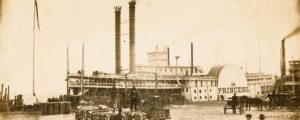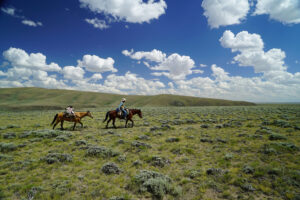In 1880 the Atlantic & Pacific Railroad began constructing a bridge over 250-foot-deep Canyon Diablo, midway between Winslow and Flagstaff. Financial difficulties halted the project, leaving an incomplete span at rail’s end. A town sprang up on the east side of the canyon, its population reaching about 2,000—mostly railroad workers, fugitives, gamblers and prostitutes.
At its peak, Canyon Diablo boasted 14 saloons, 10 gambling houses, four brothels and several grocery and dry goods stores. The poorly built shacks faced each other along a one-mile stretch appropriately dubbed “Hell Street.”
“Clabberfoot Annie” and “Bullshit Mary,” the madams of Hell Street’s two most notorious brothels, often engaged in heated arguments that led to violent wrestling matches, much to the delight of Canyon Diablo’s residents.
Trains from Winslow stopped frequently to transfer goods to the stage line toward Flagstaff and points beyond. Robbery was a regular and expected occurrence, leading sawmill operators and Flagstaff businessmen to hire peace officers. The first lawman reportedly began his duties one day at 3 p.m. and was dead in the ground by 8 p.m. Several others had varying degrees of luck, but legend has it none lived to collect his first month’s salary.
In June 1882, the Atlantic & Pacific finished the bridge, and the town, no longer a self-contained Gomorrah on civilization’s edge, virtually died overnight. The year 1886 brought a train station, and former telegraph operator Fred Volz established a trading post amid the dusty shacks, dealing with the nearby Navajo Reservation until 1910.
In 1889 four Aztec Land and Cattle Company cowboys—J.J. Smith, Daniel Harvick, William Stiren and John Halford—robbed the eastbound No. 2 train in Canyon Diablo, escaping north toward Utah Territory. Yavapai County Sheriff William Owen “Buckey” O’Neill organized a crack posse and captured the outlaws at Wahweap Canyon, just over the border. O’Neill recovered about $1,300, but evidence points to a much more lucrative heist, some $150,000, possibly cached in several spots along the escape route.
In 1905 two young men were drinking whiskey at the Wig Wam Saloon in Winslow when they decided to rob gamblers of about 600 silver dollars. They fled toward Canyon Diablo and were in hiding when a sheriff and his deputy caught up to them. In the ensuing gunfight, lawmen shot outlaw John Shaw and buried him on-site. When news of his death reached the Wig Wam, 20 drunken cowboys decided Shaw had suffered a serious injustice, as he hadn’t had the chance to finish his whiskey. They immediately hopped the train to Canyon Diablo, disinterred his corpse, stood it up and poured whiskey down his throat, giving him a final nightcap before reburying him.
Canyon Diablo is in Coconino County, three miles north of Two Guns (onetime town turned Route 66 tourist trap, now abandoned but with an exit off I-40). Little remains of Canyon Diablo today but a few foundations, one substantial stone wall and a lone tombstone.
Originally published in the October 2009 issue of Wild West. To subscribe, click here.




